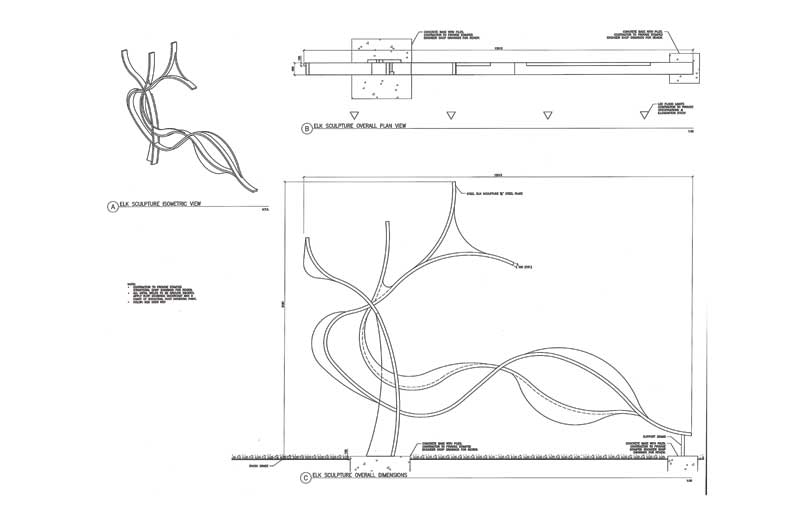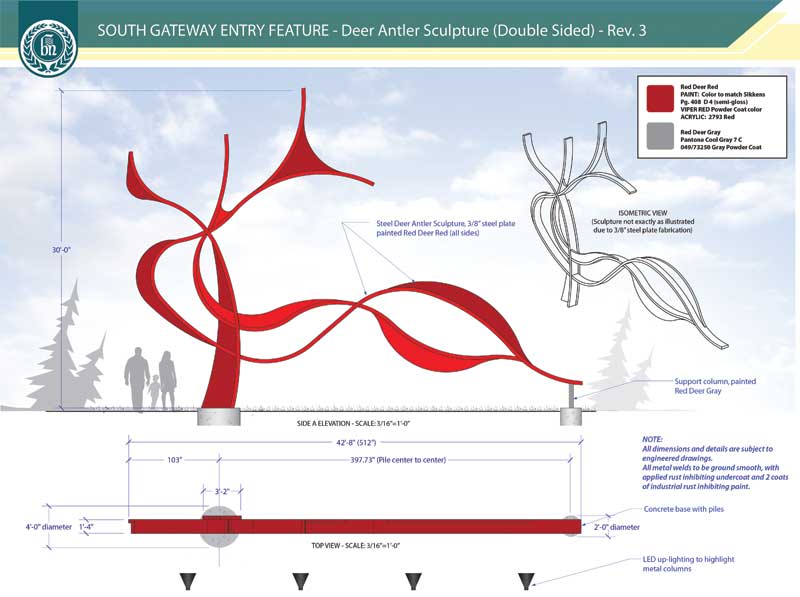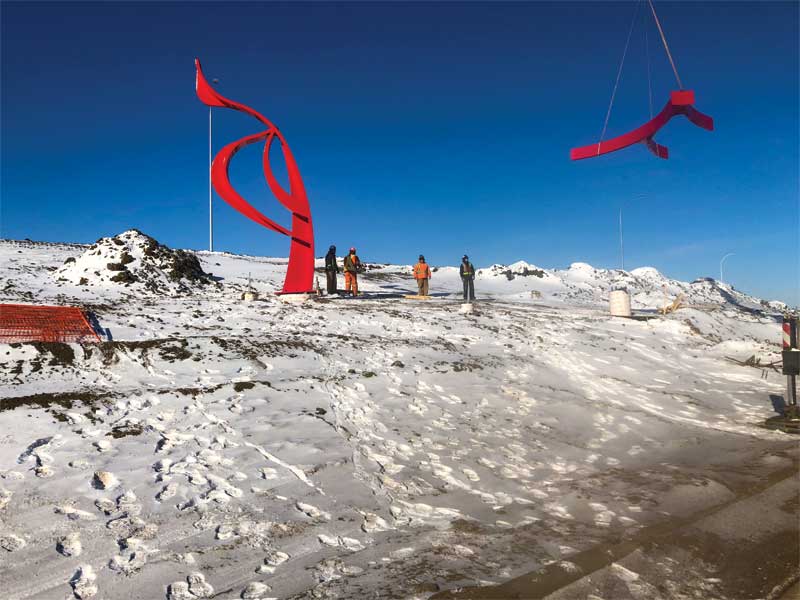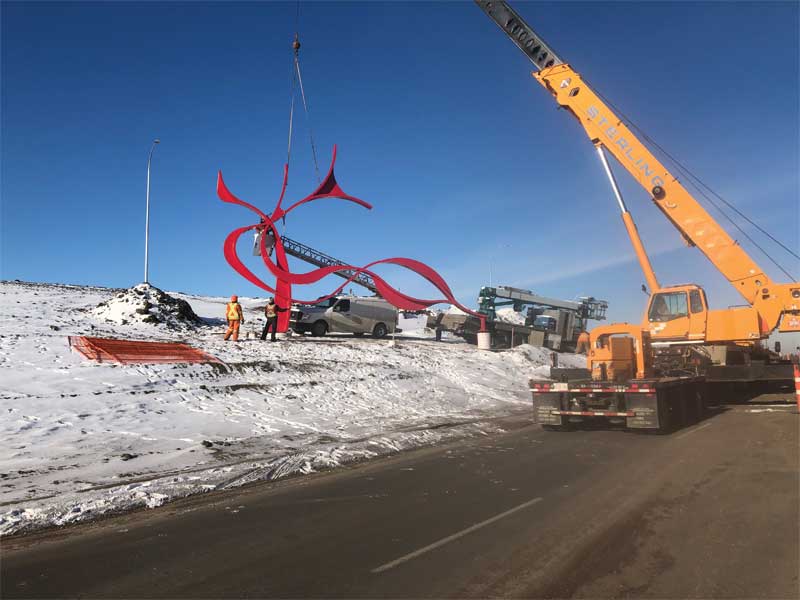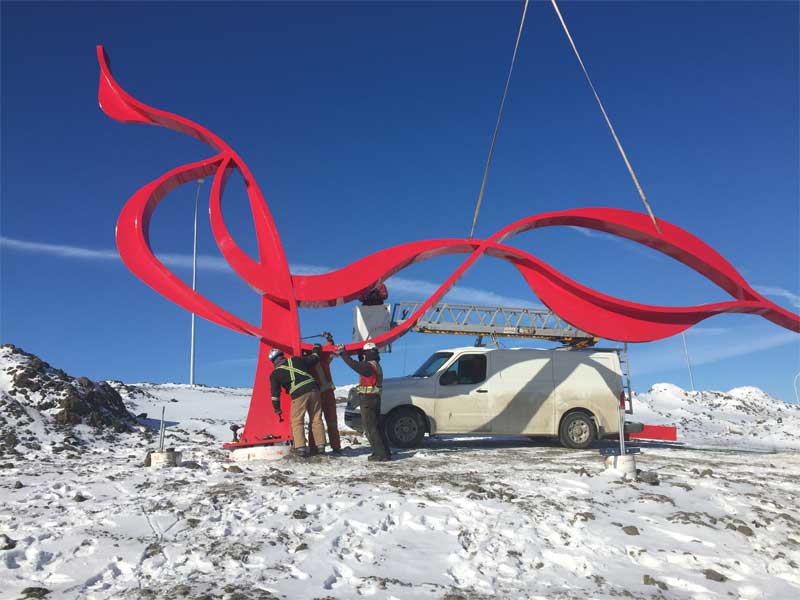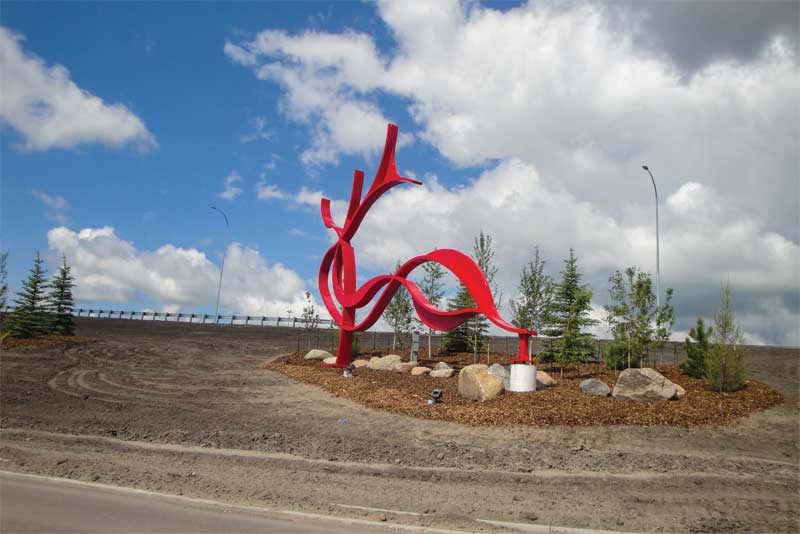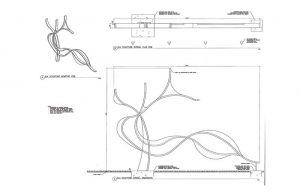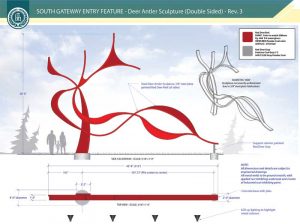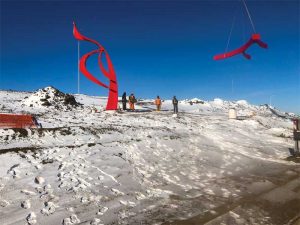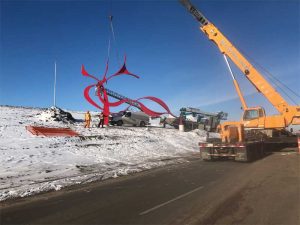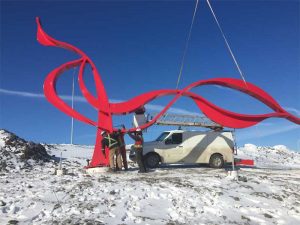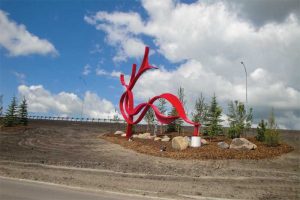Red Deer’s Warm Welcome: Gateway signage project reflects city’s refined brand image
by | 5 February 2020 12:38 pm
By Taylor Blanchett-O’Donnell
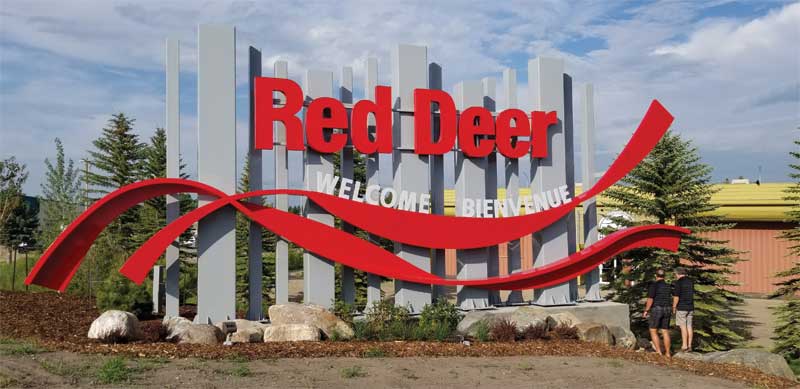 [1]
[1]One of Blanchett Neon’s largest (and certainly highest-profile) jobs completed to date was the City of Red Deer gateway signage project in Alberta, which earned the Edmonton-based signmaker the ‘Best in Show’ award and first place in the freestanding sign category in the 2019 Best of Canada’s Sign Industry Awards (BOCSIes).
Project background
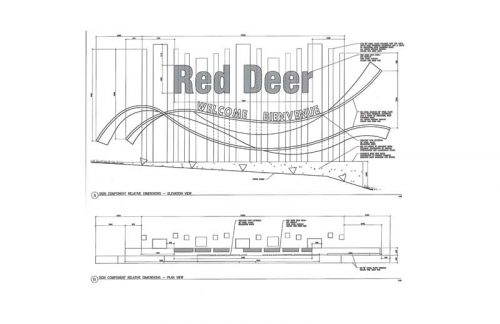 [2]
[2]In 2016, following traffic safety concerns around Gasoline Alley (a popular rest stop immediately south of the city of Red Deer, Alta.), where vehicles merged from city speeds (60 km/h [37 mph]) to highway speeds (110 km/h [68 mph]), city officials worked with Alberta Transportation and the provincial highway authority to design and ultimately construct a new interchange.
As a result, officials also knew there was a need for formal entrance displays welcoming visitors and residents to the area; therefore, as the Highway 2/Gaetz Avenue interchange project was coming to a close in late 2018, the conversation was started in regard to designating a section of land for signage purposes. With construction already taking place in the area, there was an opportunity to share costs for some aspects of the project (e.g. engineering, grating, landscaping, etc.) that were already built into the interchange budgets.
Around the same time, the city was preparing to welcome more than 25,000 visitors as the host city of the 2019 Canada Winter Games. With the high-profile event quickly approaching and knowledge of the potential cost savings it made late 2018 the right time for the city to give the project the go ahead.
Preliminary design and bidding process
Stantec, the design firm for the interchange project, created the initial conceptual designs for the two signage displays: a 6.3- x 15.6-m (20.6- x 51.4-ft) gateway sign, and a secondary 9.1- x 13-m (30- x 42.6-ft) artistic piece reflective of the city’s recently refined brand image.
As with any large-scale municipal undertaking, the ‘Gateway Signage’ project was put out to public bid through a tendered request for proposal (RFP) process.
Multiple firms (including Blanchett Neon), bid on the project, which was to include refinement of the design in addition to signage fabrication, installation, and co-ordination of engineering, concrete, electrical, and final landscaping for the two unique structures. The timeline was always very clearly noted that both displays were to be completed prior to the opening ceremonies for the Canada Winter Games.
The Alberta signage marketplace has changed significantly over the years, and with formal RFP responses now required more often than not, Blanchett Neon has assembled an internal team with the express purpose of carefully and collaboratively responding to these complex requests. Standardizing the process allows for a more thorough understanding of the scope of work and, as a result, the quality of the company’s proposals reflects in its reputation as a leader in the industry.
In this case, the City of Red Deer found the proposal to be the most attractive based on the grading criteria, and Blanchett Neon was notified in late October that its bid was successful.
Refining the design
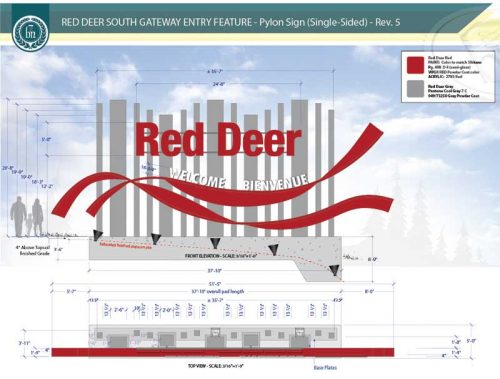 [3]
[3]With more than 70 years of experience in the design, permitting, fabrication, and installation of municipal entrance signage, Blanchett Neon knew the importance of honouring the original design intent provided by Stantec, while balancing the city brand standards, fabrication and permitting requirements, and ensuring the work could be completed at the cost presented—not to mention finishing the project within the extremely tight timeline.
After being awarded the contract, meetings were immediately arranged with Stantec and the city project managers to refine the original concepts into construction-ready drawings.
The first step was to recreate the provided drawings in the company’s preferred design software, Adobe Illustrator, followed by a second set of scaled AutoCAD drawings to share with the various suppliers and partners.
One of the design considerations included the mounting detail for the illuminated ‘Red Deer’ letters and the ‘ribbon’ to the steel pillars. Initially, the plan was to protrude knife blades from the pillars for mounting the signage elements, but ultimately, the team arrived at the decision to incorporate a raceway (painted to match the powder-coated steel), due to the ease of installation and wiring the letters and using knife blades for mounting the ribbon only.
The sign’s 15 steel pillars presented the next challenge—not to mention a number of questions about their overall intent (Were they hollow? Were they structural?) to how they would be transported from Edmonton to Red Deer (approximately 154 km [95.5 miles]), along with the orientation and mounting for each unique column.
Given the height of the individual poles (ranging from 5.3 m [17.5 ft] to 5.9 m [19.5 ft]), powder-coated hollow structural sections (HSS), complete with individual anchors for each column in the concrete pad, were found to be the most economical solution.
The ‘Elk’ design was also scrutinized to ensure that (given the size) it could be transported without the need for specialized equipment. To get around this obstacle, the drafting team (along with support from Blanchett Neon’s steel partner) was able to have the structure designed in three smaller, easily transported pieces, with fasteners hidden in curves of the display.
Once it was confirmed with Stantec and city officials that the final design met their expectations, Alberta Transportation (AT) was contacted to determine what was required
to approve the signage (as the installation locations fell under its jurisdiction). In this case, it included achieving stamped engineered drawings, and using a formal surveyor to ensure displays were placed accurately outside the highway right of way.
Project co-ordination
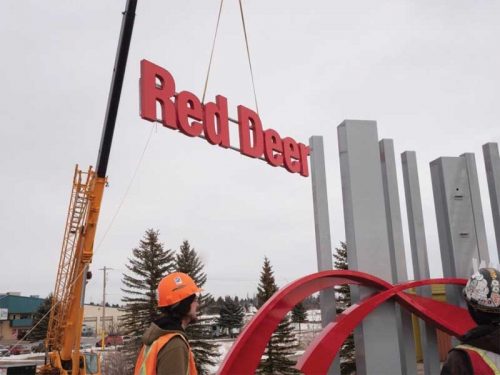 [4]
[4]When bidding on the job it was recognized the City of Red Deer was looking for a turnkey solution and that specific elements (including running conduit for power, concrete, and landscaping) fell outside of Blanchett Neon’s in-house capabilities. Therefore, the team knew it would need to lean upon its extensive partner network.
After being awarded the contract from the City of Red Deer, the company almost immediately reached out to its partners to ensure they recognized the urgency of the project and could meet the firm completion deadline.
Starting with engineering, extensive conversations took place between Stantec and Blanchett Neon’s engineer to ensure the newly constructed hillside (from completion of the intersection) met stability specifications and the new concrete signage foundations would not be affected by improper compaction as the ground continued to settle over time.
Once the drawings had been stamped, the land surveyors (as required by AT) used global positioning system (GPS) technology to ensure the exact orientation and distance from the roadway was maintained to formally stake the installation sites for review and approval by Stantec and the city.
An ongoing challenge throughout the process was unimpeded access to the worksite. With the other construction in the area still underway, Blanchett Neon was required to maintain the flow of traffic along the busy corridor and no complete road closures were permitted. To mitigate the risk to passersby and to protect crews working on-site, a formal traffic accommodation plan was created. Extensive safety measures were also taken including the use of a flagger, signage, and barricades for the duration of the project.
In addition to the firm project timeline, winter conditions were also a factor as they would present a different set of challenges
and completing the concrete foundations (including excavating the frozen ground) was no exception. Custom forms (more than 0.30 m [1 ft] thick) were constructed on-site, and polymer additives—along with site heating and hoarding—ensured the concrete cured properly despite an average daytime temperature of -20 C (-4 F).
While the concrete was being completed by one partner, the sign installation team worked with the city to determine the placement of the new transformer that would feed the light-emitting diode (LED) fixtures for the illuminated displays, and how to tie power into existing services (avoiding other underground utilities in the process). Keeping the site access restrictions in mind, the team’s solution was
to trench power approximately 300 m (984 ft) directly to the gateway display, and then directionally drill the power beneath the access road to the ‘Elk’ (another 100 m [328 ft]) to service the displays.
Installation
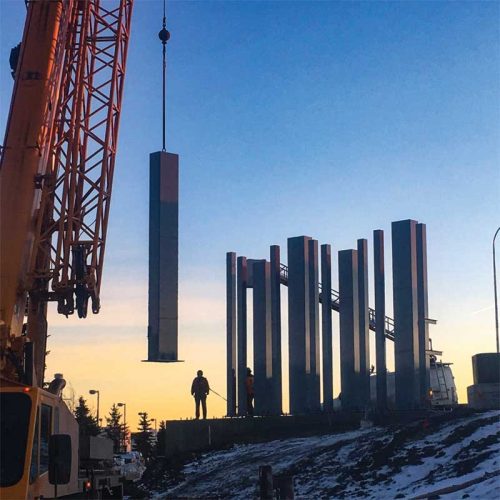 [5]
[5]With the deadline fast approaching, as soon as the concrete set, crews transported the signage elements to the site and began erecting the structures. First up were the columns for the ‘Gateway Sign.’ The installation team started here as it allowed the electrical contractor to pull the power up the pole to complete the final connection. The crew concluded with the ‘Elk’ component.
As the installation took place in February, weather was an ongoing concern; however, the team was extremely fortunate to have favourable conditions. Despite some of the coldest weather conditions in years, there were no severe storms or winds that would have shut down the project site. Ultimately, the signage installation was completed ahead of schedule. In fact, both displays were fully commissioned and operational a few days prior to the deadline, in time to welcome visitors, athletes, and residents to the Canada Winter Games.
Landscaping was the final step in the process. It was completed slightly later than expected in the summer of 2019 as a result of the unseasonably wet spring; however, it was still on budget.
Reception to the finished project could not have been more positive, with the city’s director of communications and strategic planning, Julia Harvie-Shemko, quoted in the Red Deer Express stating, “It symbolizes Red Deerian residents’ connection to each other, to nature, and the river that connects the city.”
Taylor Blanchett-O’Donnell is part of the fourth generation to work at Blanchett Neon, a family-owned and operated custom sign company in Western Canada. In her role as corporate services manager, she is responsible for business development, health and safety, brand presence, strategic direction, and works alongside senior management and the ownership group to develop, demonstrate, and execute the company’s vision of excellence. Blanchett-O’Donnell, named to the International Sign Association (ISA) Elite class of 2018, is one of the founding members of the Young Professionals Network (YPN) and serves as the group’s vice-president. She is also an active member in both the Alberta and national sign association. She can be reached via email at tblanchett@blanchettneon.com.
- [Image]: https://www.signmedia.ca/wp-content/uploads/2020/02/Welcome-to-Red-Deer-2.jpg
- [Image]: https://www.signmedia.ca/wp-content/uploads/2020/02/Stantec-Rendering-Gateway-Sign.jpg
- [Image]: https://www.signmedia.ca/wp-content/uploads/2020/02/BNL-Artistic-Rendering-Gateway.jpg
- [Image]: https://www.signmedia.ca/wp-content/uploads/2020/02/crane-op-1.jpg
- [Image]: https://www.signmedia.ca/wp-content/uploads/2020/02/IMG_3992.jpg
Source URL: https://www.signmedia.ca/red-deers-warm-welcome-gateway-signage-project-reflects-citys-refined-brand-image/
